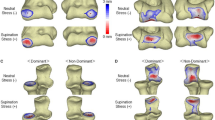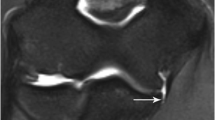Abstract
Objective
Multimodality elbow screening of adolescent baseball players shows apparent laterality in morphology and signal intensity of the medial epicondyle on dedicated magnetic resonance imaging. We aimed to elucidate actual imaging laterality in the medial epicondyle by comparing magnetic resonance images of the dominant and contradominant elbows and to clarify the clinical meaning and mechanism of this phenomenon.
Materials and methods
We used a 0.2-T dedicated magnetic resonance imaging scanner. Eighty adolescent baseball players were enrolled and divided into four age groups: 9–10 years (13 patients); 11 years (28 patients); 12 years (24 patients) and 13–14 years (15 patients). The long and short axes of the ossification center and distance of the epiphyseal plate and the cartilage of the lower pole of the medial epicondyle were measured. Signal intensity of the ossification center was visually evaluated.
Results
Owing to their age, ossification and cartilage size on the dominant side were significantly larger in all boys (P < 0.01). All age groups had larger ossification and cartilage in the dominant elbow (P < 0.01). Ossification showed an apparent lower signal intensity on the dominant side (P < 0.01).
Conclusions
Larger ossification and cartilage size of the medial epicondyle in the dominant elbow suggested that the medial collateral ligament to the medial epicondyle induces excessive repetitive tensile stress, but without clinical symptoms. Functional or microanatomical damage of the medial epicondyle may induce a lower ossification signal in the dominant elbow, thereby decreasing fatty bone marrow and inducing sclerotic changes.




Similar content being viewed by others
References
Kida Y, Morihara T, Kotoura Y, et al. Prevalence and clinical characteristics of osteochondritis dissecans of humeral capitellum among adolescent baseball players. Am J Sports Med. 2014;42:1963–71.
The Japanese Orthopaedic Association. 2016. https://www.joa.or.jp/media/comment/pdf/2016_survey_childrensbaseball.pdf. Accessed 17 June 2016
Otoshi K, Kikuchi S, Kato K, et al. Age-specific prevalence and clinical characteristics of humeral medial epicondyle apophysitis and osteochondritis dissecans: ultrasonographic assessment of 4249 players. Orthop J Sports Med. 2017;5:2323967117707703.
Matsuura T, Suzue N, Iwame T, Arisawa K, Fukuta S, Sairyo K. Epidemiology of shoulder and elbow pain in youth baseball players. Phys Sportsmed. 2016;44:97–100.
Matsuura T, Suzue N, Kashiwaguchi S, Arisawa K, Yasui N. Elbow injuries in youth baseball players without prior elbow pain: a 1-year prospective study. Orthop J Sports Med. 2013;1:2325967113509948.
Matsuura T, Suzue N, Iwame T, Nishino S, Sairyo K. Prevalence of osteochondritis dissecans of the capitellum in young baseball players: results based on ultrasonographic findings. Orthop J Sports Med. 2014;2:2325967114545298.
Harada M, Takahara M, Mura N, Sasaki J, Ito T, Ogino T. Risk factors for elbow pain injuries among young baseball players. J Shoulder Elb Surg. 2010;19:502–7.
Okamoto Y, Maehara K, Kanahori T, Hiyama T, Kawamura T, Minami M. Incidence of elbow injuries in adolescent baseball players: screening by a low field magnetic resonance imaging system specialized for small joints. Jpn J Radiol. 2016;34:300–6.
Tanaka K, Okamoto Y, Makihara T, et al. Clinical interpretation of asymptomatic medical collateral ligament injury observed on magnetic resonance imaging in adolescent baseball players. Jpn J Radiol. 2017;35:319–26.
Greenberg SB, Faerber EN, Aspinall CL, Adams RC. High-dose chloral hydrate sedation for children undergoing MR imaging: safety and efficacy in relation to age. Am J Roentgenol. 1993;161:639–41.
Greenberg SB, Faerber EN, Radke JL, Aspinall CL, Adams RC, Mercer-Wilson DD. Sedation of difficult-to-sedate children undergoing MR imaging: value of thioridazine as an adjunct to chloral hydrate. Am J Roentgenol. 1994;163:165–8.
Rosenberg DR, Sweeney JA, Gillen JS, et al. Magnetic resonance imaging of children without sedation: preparation with simulation. J Am Acad Child Adolesc Psychiatry. 1997;36:853–9.
Gugenheim JJ Jr, Stanley RF, Woods GW, Tullos HS. Little league survey: the Houston study. Am J Sports Med. 1976;4:189–200.
Hang DW, Chao CM, Hang YS. A clinical and roentgenographic study of little league elbow. Am J Sports Med. 2004;32:79–84.
Weinstein SL, Flynn JM. Lovell and Winter’s pediatric orthopaedics. 7th ed. Philadelphia: Lippincott Williams & Wilkins; 2014. p. 309–10.
Ogden JA, Southwick WO. Osgood–Schlatter’s disease and tibial tuberosity development. Clin Orthop Relat Res. 1976;116:180–9.
Hirano A, Fukubayashi T, Ishii T, Ochiai N. Magnetic resonance imaging of Osgood–Schlatter disease: the course of disease. Skelet Radiol. 2002;31:334–42.
Arnaiz J, Piedra T, Cerezal L, et al. Imaging of Kienböck disease. Am J Roentgenol. 2014;203:131–9.
Acknowledgements
I would like to express my greatest appreciation to Dr. Atsushi Hirano for his useful discussion and idea regarding this work.
Author information
Authors and Affiliations
Corresponding author
Ethics declarations
Conflict of interest
The authors declare that they have no conflicts of interest.
Informed consent
Informed consent was obtained from all individual participants included in the study.
Ethical approval
All procedures involving human participants were in accordance with the ethical standards of the institutional and/or national research committee and with the 1964 Helsinki Declaration and its later amendments or comparable ethical standards.
Rights and permissions
About this article
Cite this article
Yoshizawa, T., Okamoto, Y., Tanaka, K. et al. Normal imaging laterality on magnetic resonance imaging of the medial epicondyle of the elbow on the dominant side of adolescent male baseball players. Skeletal Radiol 47, 1237–1244 (2018). https://doi.org/10.1007/s00256-018-2921-9
Received:
Revised:
Accepted:
Published:
Issue Date:
DOI: https://doi.org/10.1007/s00256-018-2921-9




